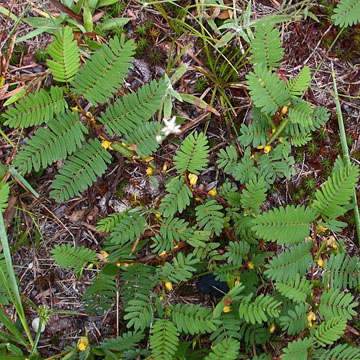

Chamaecrista nictitans - (image 1 of 3)
Taxonomy
Family: Fabaceae
Habitat
Dry upland woods, dunes, disturbed habitats, often in sandy soil.
Associates
Distribution
MA and southern VT to NY, OH, MO, and KS, south to the tropics.
Morphology
Annual; stems erect, 10-50 cm, glabrous to villous; petiolar gland saucer-shaped, short-stalked; leaflets in 7-20 pairs, oblong, 6-15 mm, aristate, usually glabrous; flowers solitary or 2-3 together, on pedicels 2-4 mm; petals very unequal, on 6-8 mm and nearly or fully twice as long as the others; stamens 5, unequal, filaments very short; anthers 1.5-3 mm; pods oblong, straight, flat, 2-4 cm long and 3-6 mm wide.
Notes
Flowers July to September
Wetland indicator: FACU
This species is vegetatively similar to C. fasciculata but with the gland on the petiole short-stalked rather than sessile. It also has five stamens (vs. 10 stamens) and smaller flowers, with the longest petal under 1 cm long and the others much shorter (vs. petals 1-2 cm long and all about the same size). The leaflets of both species are said to fold together when touched, however I have found that neither one really does this. The foliage is similar to Mimosa pudica which is known for its dramatic rapid nastic movements.
References
Gleason, Henry A. and A. Cronquist. 1991. Manual of Vascular Plants of
Northeastern United States and Adjacent Canada. Second Ed.
The New York Botanical Garden. Bronx, NY
|
© Michael Hough 2018 |